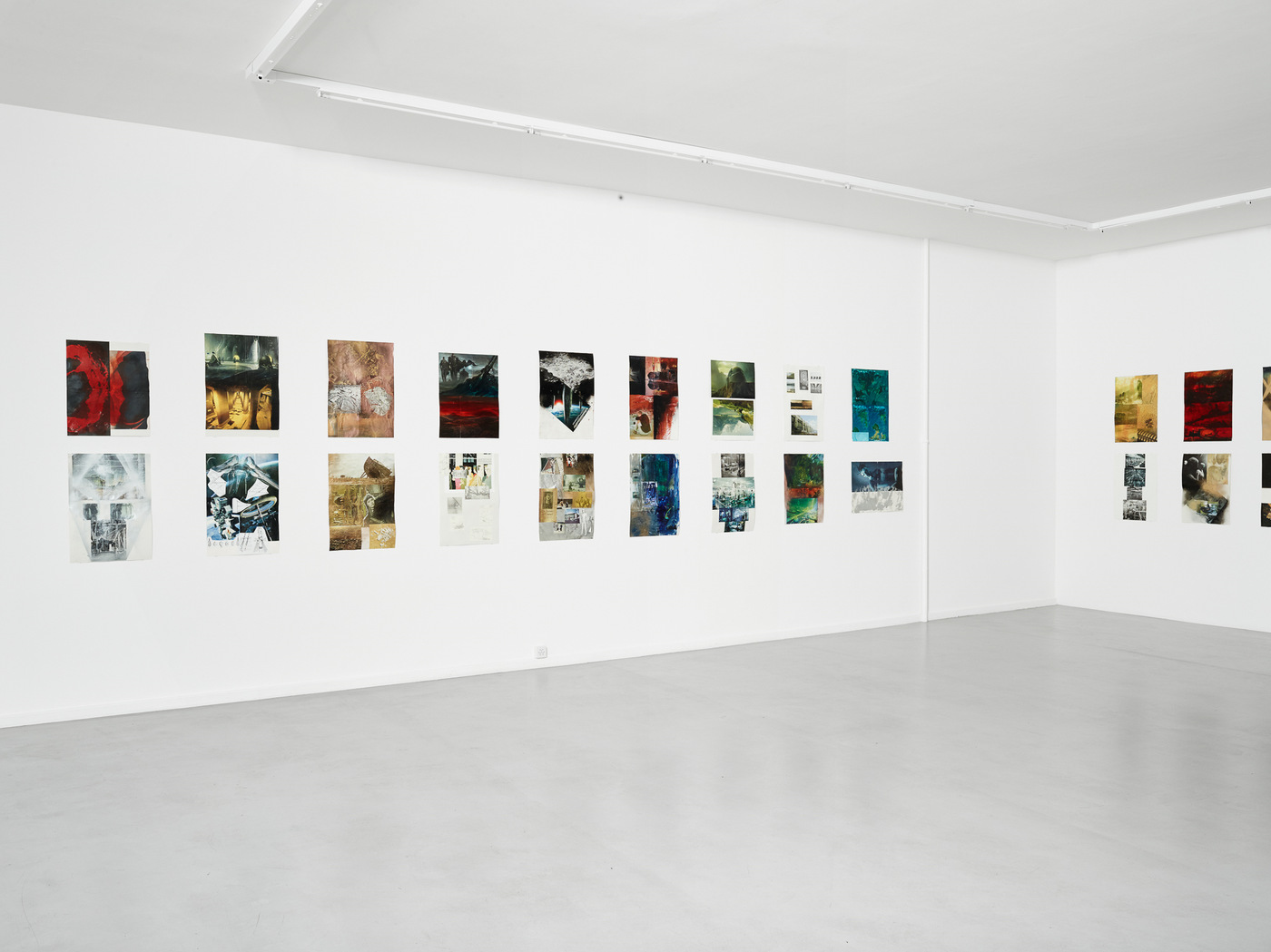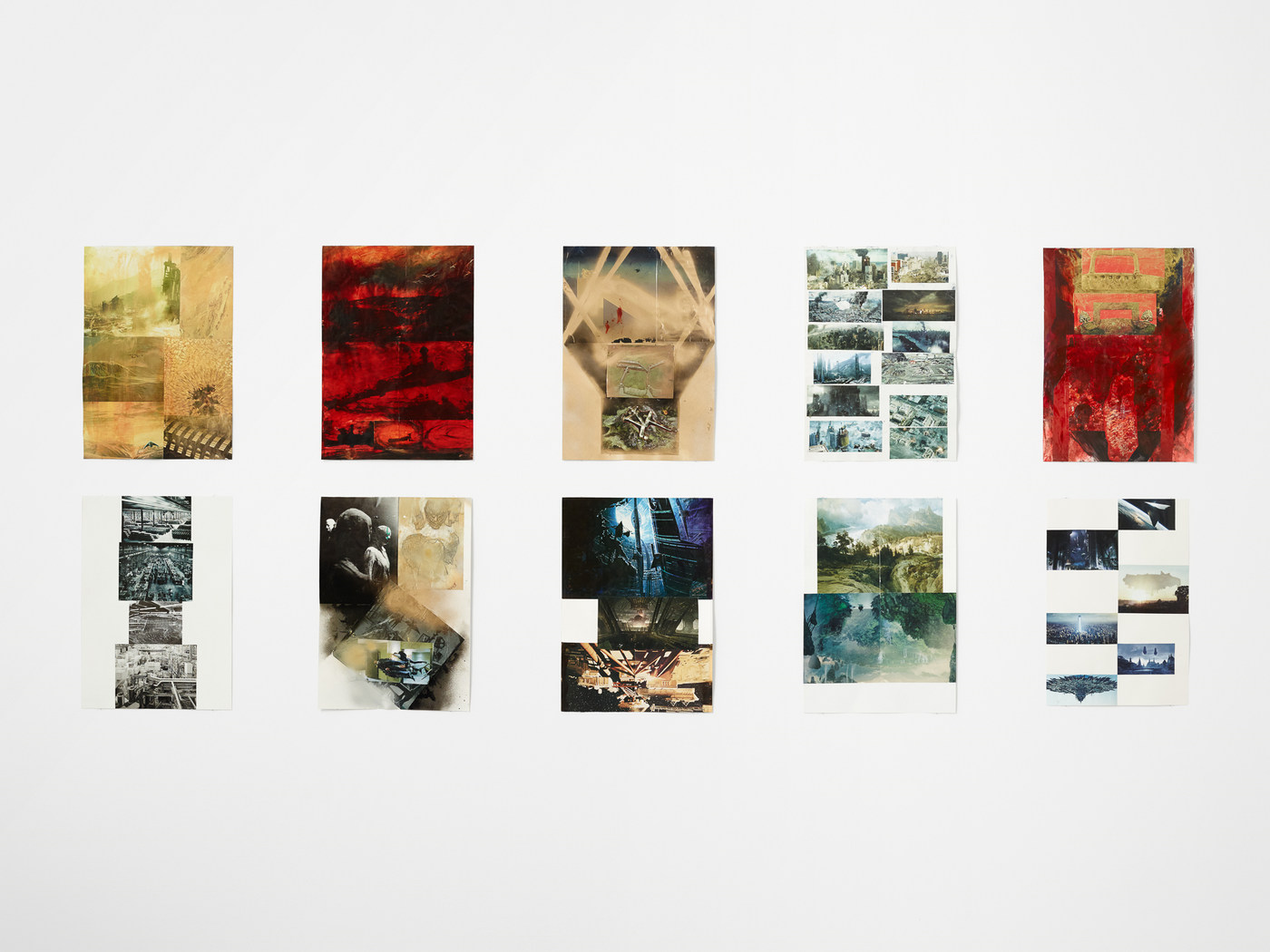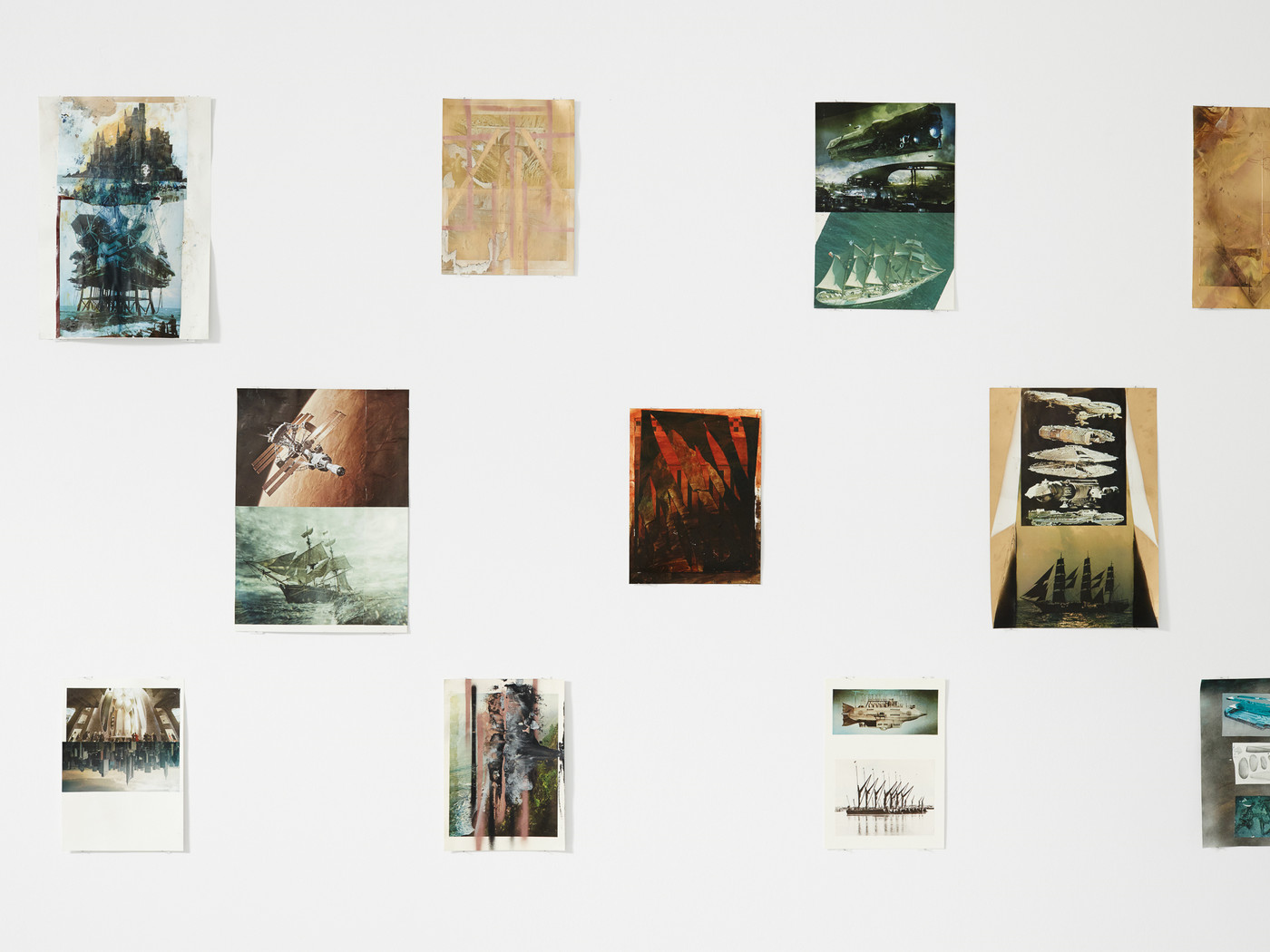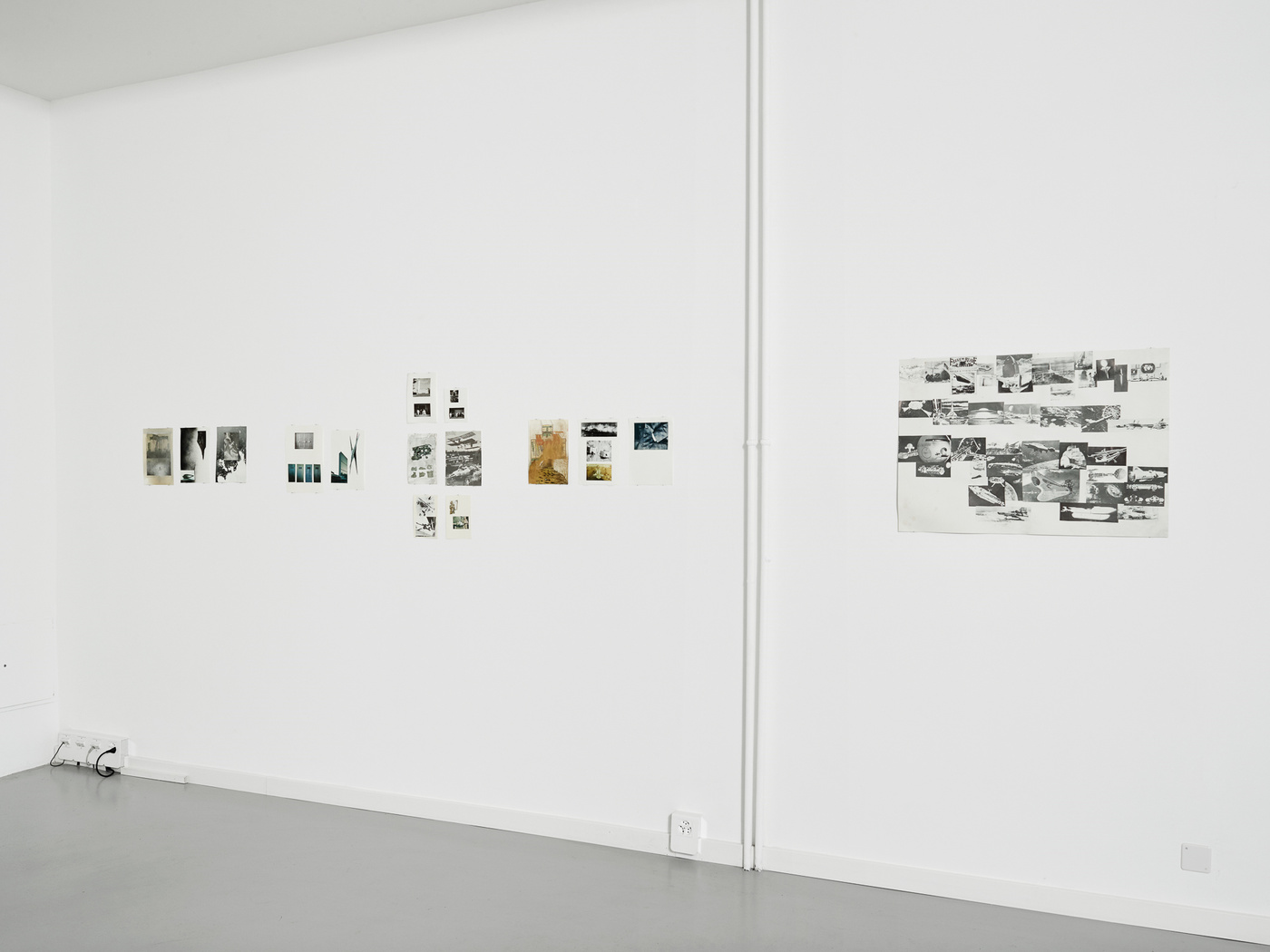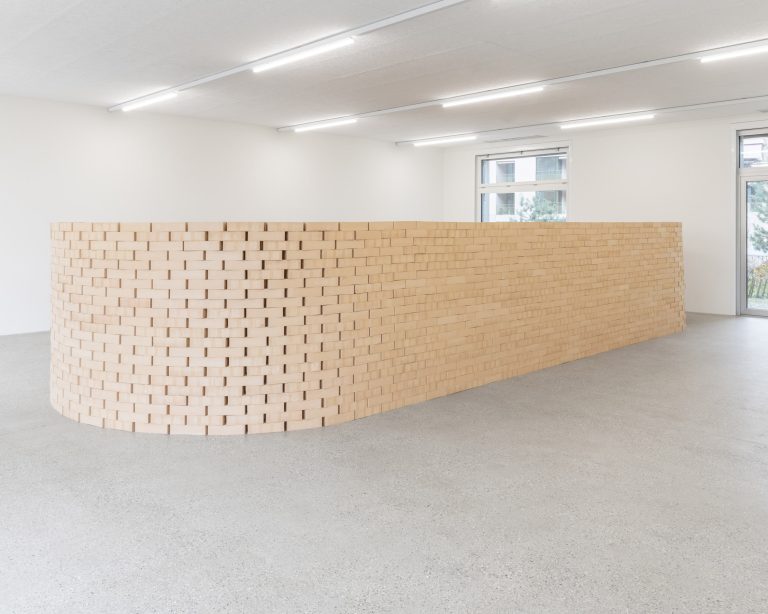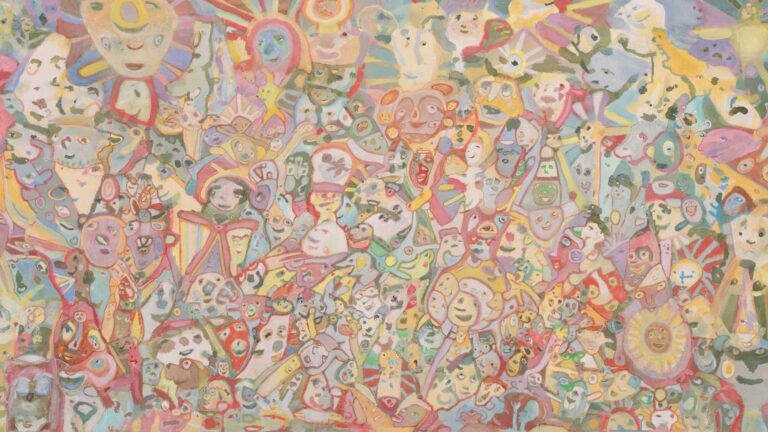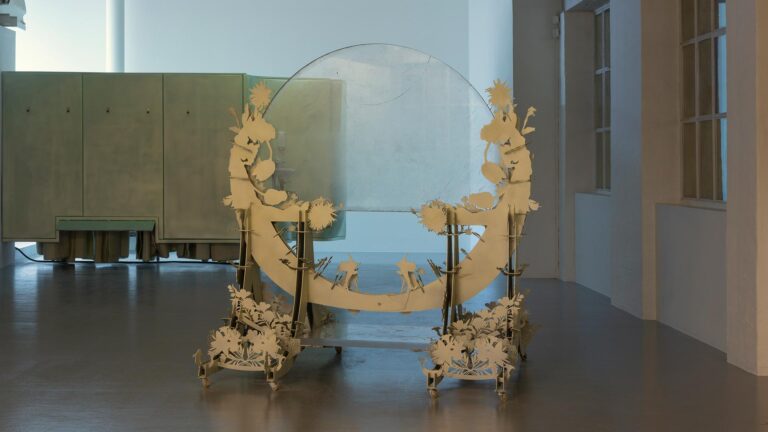Artist: Mathis Gasser
Exhibition title: Sept sont tombés vers le ciel
Venue: The Centre d’édition contemporaine, Geneva, Switzerland
Date: May 20 – September 3, 2015
Photography: Sandra Pointet, images copyright and courtesy of the artist and Courtesy Centre d’édition contemporaine, Geneva
Mathis Gasser draws upon and combines thousands of images that he patiently gathered and arranged in a personal archive. Their references come from the arts, architecture, cinema, comics, science fiction, magazines or from current events. In a very elaborated practice of collage, thousands of signs collide and are multiplied in an explosive combination, in a mirror or imbricating effect, diffracted by the immateriality of the digital world and by the invasion of information. The impact that Gasser seeks for through this body of reappropriated, reassociated images that are frequently reworked through drawing and painting, and caught in a sustained and invasive turnover. They oscillate between a nihilistic vision and an interrogation of the limits of a world undermined by temptations of archaism and the resurgence of primal fears, sectarian deliriums, theories of conspiracy and hyper technological and futuristic extravaganzas and other prophecies.
May it echo the explosion of a globalised, out of limit, surreal present or more historical, cultural and artistic references, this proliferation is constructed by Gasser in several series. One of them will constitute a part of the 600-page book edited by the CEC and entitled In the Museum 1 /2 (3). « In the museum » because Mathis Gasser considers the space of the museum as the receptacle for artworks and also as a place interpenetrated by elements that belong to the economic, social, digital, scientific or media world. The second series, Regulators, engages in and develops a more critical and political vision of our society.
In In the Museum 1 /2 (3), the museum is seen as a platform that is in constant dialog between dead objects, artworks and the flow of life. Gasser relates artworks to zombies, objects and living beings at the same time, pre-technological objects, like paintings, and others manipulated by information, new technologies and the virtual world. Artworks kept alive artificially by historical discourse, by museum education and communication.
Mathis Gasser imagines his own museum: a retrofuturistic projection, penetrated by magnetic waves or by zombies, crossed by an implicit tension and symptoms of an upcoming chaos. In this imaginary museum the works are plunged in a battle between life and death, horror and aesthetics, where even the doppelganger puppet of Christopher Walken (film In the Museum 1 and 2) – this phantom-like, troubling, almost borderline Hollywood figure with a strange and sharp gaze and who seems to come from another place – represents a sort of a stereotypical half-living creature. In these films, Walken walks around in an immaculate mock-up of a fictive museum without relief, and is attacked by artworks whilst at the same time protected by zombies. This tinkered and fantastic story, overflown with blood-stained works and half-dead, would pose as a mirror to our society affected by new expressions of violence, occult forces, primal and irrational fears.
The zombie represents the living-dead, a voracious and hysterical cannibal devouring its ex-congeners, reduced by rising consumerism, turned into an over-adapted, self-regulated, unceasingly consuming and communicating machine, drawn towards self-destruction by the capitalist system, the perfect image of auto-cannibalism. For Mathis Gasser, the museum represents a sort of an institutional matrix, like the United Nations or the European Union that synthesises and symbolises Western beliefs. The contemporary art museum would represent this same prophetic space. Gasser fills it with troubling and monstrous characters – Walken and the zombies – themselves pure products of the matrix account who seem to benefit from and disturb at the same time the establishment. These ghostly figures who occupy the museum represent the collective subconscious, which, behind the appearances, influences our society, disrupts its organisation and its mythologies and emphasises its dark and deadly side.
The second series that will be reproduced in this book will constitute the second chapter, Regulators 1 / 2 (n). This generic title, Regulators, marks a stronger connection with the outside world, its state, its topicality, its development. Gasser still envisages it in a fictional, futurist or retrofuturistic way, but also as a universe that is more in phase with our reality, unregulated and prone to multiple drifts and disasters (climatic, ecological), to economic crisis (stock market crashes, casino-economy, high frequency trading), to plagues and to terrorism. A land still inhabited by vampires and other zombies, unconscious beings, where ultra violence reigns, a drift that explodes the limits, the landmarks, moral framework and that creates volatility.
This undefined and liquid world leaves the door open to new beliefs, such as sects and secret societies, illuminati and other conspirationsists. The expanding globalisation that was generated by Western capitalism, and which goes beyond all rules andregulation, blows to pieces all common moral and identity references, provoking a black whole, an apocalyptical end of the world impression where theories of science fiction and also instincts of regression, anti-democracy and fascism are summoned. All of these themes that were already tremendously seized by the cinema and TV oscillate between a completely hi-tech and dehumanised future and the return to delirious and unrestrained archaism. We can mention, among others, eXistenZ by David Cronenberg, or the first season of True Detective, Jane Campion’s Top of the Lake or the more recent Ex Machina by Alex Garland.
The term “regulators” makes reference to regulation systems that are set in the financial sphere that Gasser envisages in the background of his work, as a commentary and expression of the emergency and the next foreseeable explosions: new financial, ecological, religious and political distress and the resurgence of some forms of fascism. Most of Gasser’s films put on stage small tales and figures that walk around in mock-ups made by Gasser himself. More recently, he proposed a live performance with real actors who moved around in the exhibition space, dressed as Japanese No or Bunraku theatre characters. For Gasser, the figures of the Regulators series do not represents harmful agents, but rather beings inclined to invent new “contemporary rituals” more open and more inspired by notions of abstraction, aesthetics and ethics.
The exhibition of Mathis Gasser presents an entirely new series of works on paper executed on-site at the CEC, during the period that preceded the opening.
Mathis Gasser, Sept sont tombés vers le ciel, exhibition view at CEC, 2016
Mathis Gasser, Sept sont tombés vers le ciel, exhibition view at CEC, 2016
Mathis Gasser, Sept sont tombés vers le ciel, exhibition view at CEC, 2016
Mathis Gasser, Sept sont tombés vers le ciel, exhibition view at CEC, 2016
Mathis Gasser, Sept sont tombés vers le ciel, exhibition view at CEC, 2016
Mathis Gasser, Sept sont tombés vers le ciel, exhibition view at CEC, 2016
Mathis Gasser, Sept sont tombés vers le ciel, exhibition view at CEC, 2016
Mathis Gasser, Sept sont tombés vers le ciel, exhibition view at CEC, 2016
Mathis Gasser, Sept sont tombés vers le ciel, exhibition view at CEC, 2016
Mathis Gasser, Sept sont tombés vers le ciel, exhibition view at CEC, 2016
Mathis Gasser, Sept sont tombés vers le ciel, exhibition view at CEC, 2016
Mathis Gasser, Sept sont tombés vers le ciel, exhibition view at CEC, 2016
Mathis Gasser, Sept sont tombés vers le ciel, exhibition view at CEC, 2016
Mathis Gasser, Sept sont tombés vers le ciel, exhibition view at CEC, 2016
Mathis Gasser, Sept sont tombés vers le ciel, exhibition view at CEC, 2016
Mathis Gasser, Sept sont tombés vers le ciel, exhibition view at CEC, 2016
Mathis Gasser, Sept sont tombés vers le ciel, exhibition view at CEC, 2016
Mathis Gasser, Sept sont tombés vers le ciel, exhibition view at CEC, 2016
Mathis Gasser, Sept sont tombés vers le ciel, exhibition view at CEC, 2016
Mathis Gasser, Sept sont tombés vers le ciel, exhibition view at CEC, 2016
Mathis Gasser, Sept sont tombés vers le ciel, exhibition view at CEC, 2016


